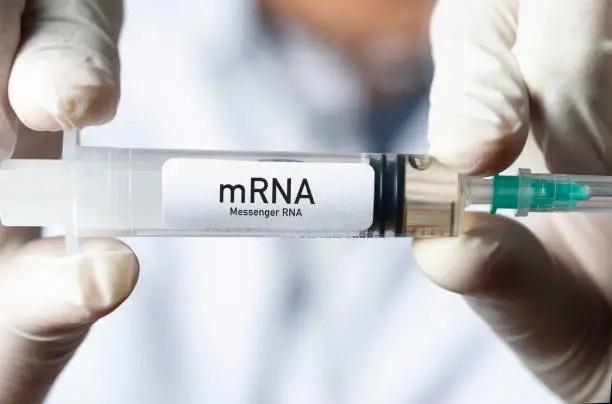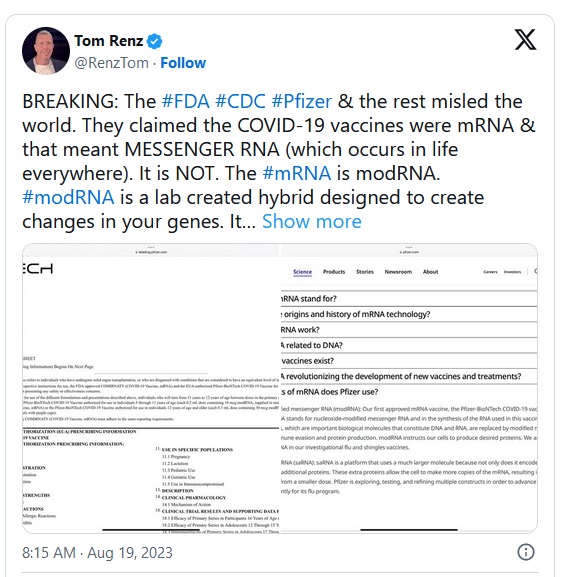by Tom Renz, The Tenpenny Report:

Ah, it is so refreshing to read the long history of mRNA, according to Johns Hopkins University. mRNA was discovered in the 1960s, and in the 1970s, research began on how to deliver it into cells. It took 50 years and a COVID-19 pandemic and voila! The first mRNA jabs were brought to market in 2020.
What happened during the gap? Testing in mice happened in the 1990s and an mRNA rabies vaccine was tested in humans in 2013. I don’t think that went well. What about the other years? Research and more research, because the mRNA quickly degraded once inside the body before it could deliver its “message” (the RNA transcript, so to speak) to the cells.
TRUTH LIVES on at https://sgtreport.tv/
Nanotechnology solved that problem. In particular, lipid nanoparticles wrapped the mRNA into a protective fatty bubble so that it could safely enter the cell. Once inside, the protein production could begin, meaning spike protein in the case of the SARS-CoV-2 virus. Ebola virus vaccines were developed using these new lipid nanoparticles, but Ebola is rare, and had zero commercial potential in the US. But a COVID pandemic did – and still does.
Fast forward to now, and new vaccines are coming out for the latest fall variants. Dozens of mRNA vaccines are also being developed for everything under the sun. According to Johns Hopkins University, this technology was proven extremely safe and effective during COVID. The FDA agreed, and Pfizer’s mRNA COVID jab was the first to achieve full FDA approval in the United States. Now everyone is racing to the finish line.
Fast forward, and GSK has just obtained FDA approval for its new mRNA vaccine called Arexvy, heralded as a vaccine “50 years in the making” and one that “could save hundreds of thousands of lives each year on a global scale” to solve the adult RSV disease that has “flown under the radar for so many years.” You know, it’s [adult RSV] the “worst disease no one has heard of.” Yes – a doctor actually said that. Sigh. Less than a month later, the FDA approved Pfizer’s version of the mRNA RSV jab called Abrysvo, and Moderna has one in the works as well. Dr. Tenpenny wrote about this travesty in The Next Billion Dollar Vaccine Deal (Part 1 and Part 2).
A whole host of other mRNA vaccines are under development. There are four mRNA flu vaccines, and Moderna’s combination COVID/flu jab. There are upcoming mRNA jabs for Zika virus, HIV, cytomegalovirus (CMV) and even cancer.
The Best Thing Since Sliced Bread
mRNA vaccines sound incredible. What if an mRNA vaccine could be developed for each ailment known to man? We could eradicate disease! There is just one problem:
mRNA is not what we’ve been told it is.
So what is it? Lawyer Tom Renz says that what Pfizer and others widely advertise as mRNA (the widely adopted scientific abbreviation for messenger RNA) is actually modRNA, a lab-created hybrid concoction.

Does it matter? Yes, there is a BIG difference between the two.
First, messenger RNA is natural; your body has mRNA inside cells. Think of mRNA as a set of instructions that the cell uses to make proteins your body needs. The FDA product label for Pfizer’s Comniraty COVID-19 mRNA jab shows that mRNA refers to artificially modified RNA (modRNA). RNA has four natural compounds, and one of them, uridine, is modified to make a synthetic form known as modRNA. Pfizer confirms it on the website: they’ve taken regular messenger RNA and have replaced portions of it to help enhance the immune system and protein production.
In short, it means this lab-created concoction is designed to create changes in your genes.
What could go wrong?
A lot. Remember from above that mRNA breaks down easily in the body. This was always the issue with the mRNA vaccines. However, modRNA can last longer and can also create permanent changes in genes. ModRNA has been intentionally altered at specific sites, and it stays in the body longer, maybe forever. Therefore, it can have “massive unintended consequences in the 3300 billion lines of genetic code that make up humanity,” according to Renz.
A Very Different Beast
Klaus Steger, a molecular biologist and Epoch Times reporter, specializes in this type of gene regulation. He wrote a very informative piece on modRNA, showing that it is indeed very different than mRNA. Steger points out that it evokes a reduced stimulation of the immune system. This can lead to antibody dependent enhancement (ADE), something Dr. Tenpenny has been saying since the beginning in her 40 Mechanisms of Injury book. The antibodies are strong enough to bind to the pathogen but too weak to prevent infection, instead acting as a “Trojan horse” that allows the pathogen into the cell. When a vaccinated person gets infected, mild illness can occur as can breakthrough illness where the vaccine does not induce high enough levels of immunity to stop a severe infection. Sound familiar? It should, since the CDC just dropped this information on the public: “The new BA.2.86 COVID-19 lineage may cause infection in people who received vaccines or previously had the virus.”
Read More @ TheTenpennyReport.com



